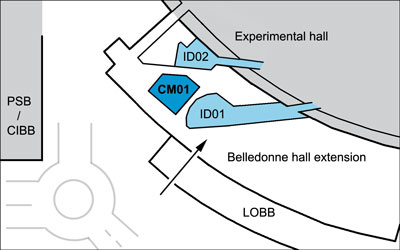- Home
- Users & Science
- Find a beamline
- Structural biology
- Our beamlines
- CM01 Cryo-electron microscope
CM01 Cryo-electron microscope
Synopsis
The ESRF has acquired a Titan Krios cryo-electron microscope (cryoEM) for single particle experiments. It is equipped with a K3 direct electron detector, a Quantum LS imaging filter and a Volta phase plate (VPP). The microscope is situated at the ESRF and is run as a beamline (CM01) with access for the international Structural Biology community given on scientific merit through rolling-access applications. In the longer term, CM01 will be part of a cryoEM platform run within the Partnership for Structural Biology (PSB) in conjunction with the microscopes located at the IBS and the EMBL. A team of four scientists from the ESRF, the IBS, the ILL and the EMBL will support user operation.
Status: full user operation
Location
|
Microscope CM01 is located in the ESRF Belledonne experimental hall between beamlines ID01 and ID02. |
 |
Cryo-EM can be used for protein structure determination with near atomic resolution by single-particle imaging. At the ESRF, single particle imaging is used as a complementary technique to macromolecular crystallography and BioSAXS. For a protein that can be crystallised, macromolecular X-ray diffraction (MX) is still the most efficient means to obtain its structure at very high resolution. In contrast, BioSAXS provides low resolution details about the overall shape of a single protein or a macromolecular complex in solution. Cryo-EM has been used to obtain subnanometre-resolution structures of up to ~2 Å for ideal structures including protein complexes and viruses with sizes typically of 150 kDa and above [1]. It is commonly used for larger proteins and complexes that are intrinsically difficult to crystallise. Cryo-EM image analysis is powerful enough to enable in silico classification of different conformation states of the sample if they co-exist in solution.
An experiment
Cryo-EM data collection and analysis takes considerably longer than an X-ray diffraction experiment. Expect to screen only a few sample grids and collect data on one grid (or only a few grids) during a user session. Slots for data collection are allocated as multiples of 3 eight-hour shifts (i.e. a 24-hour day) depending on the experimental needs. At the beginning, 3 days will be allocated per experiment. Images will be collected and a first analysis (CTF estimation) will be done.
User’s data can be saved to external hard disks using a dedicated data backup PC in the control cabin. Dedicated computing power for image analysis will be provided at a later stage. Please remember to come with a hard disk drive of sufficiently large size (we recommend a USB3 connection and a disk space of 8-10 TB).
Data obtained at the ESRF should be acknowledged in any publication like: "We acknowledge the European Synchrotron Radiation Facility for provision of beam time on CM01 and we would like to thank xyz for assistance."
Please also cite the following publication in case you use data obtained on CM01 in any publication:
Kandiah E., Giraud T., de Maaria Antolinos A., Dobias F., Effantin G., Flot D., Hons M., Schoehn G., Susini J., Svensson O., Leonard G.A. & Mueller-Dieckmann C. (2019). CM01: a facility for cryo-electron microscopy at the European Synchrotron. Acta Cryst. D75, 528 - 535. https://doi.org/10.1107/S2059798319006880.
As for all accepted rolling-access projects, an experimental report has to be submitted and registered in our data base within 3 months after execution of the experiments and definitively prior to any new proposal.
References
[1] Breaking cryo-EM resolution barriers to facilitate drug discovery, A. Merk, A. Bartesaghi, S. Banerjee, V. Falconieri, P. Rao, M.I. Davis, R. Pragani, M.B. Boxer, L.A. Earl, J.L.S. Milne, and S. Subramaniam, Cell 165, 1698–1707 (2016); doi: 10.1016/j.cell.2016.05.040.




